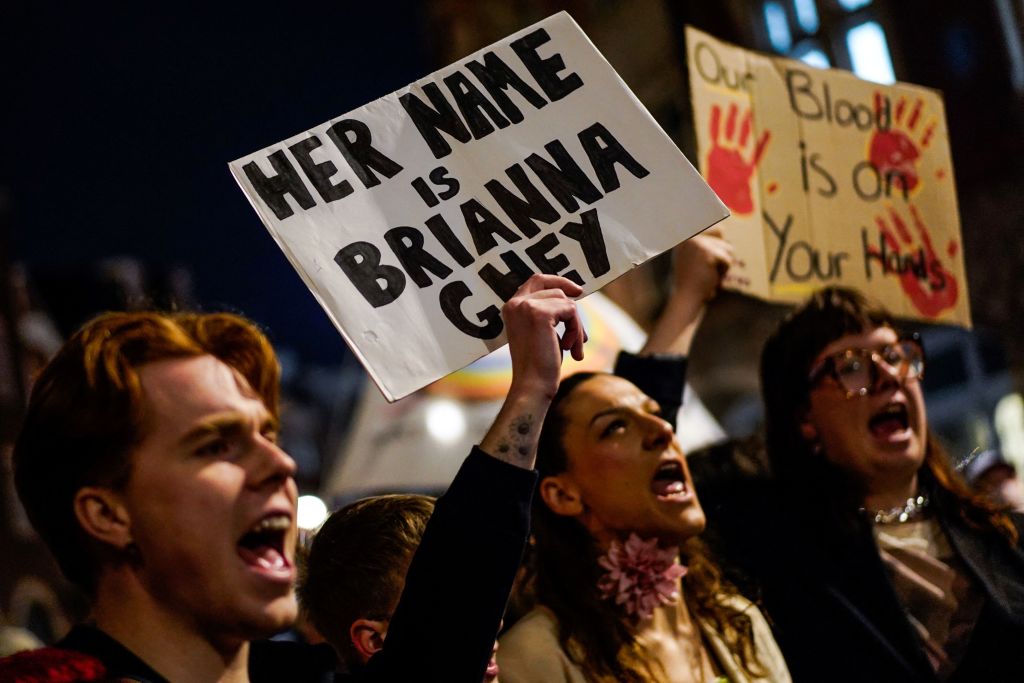In the wicked murder of poor Brianna Ghey, it’s not hyperbole to say the Devil is in the details. Thousands of text messages sent between her two teenage killers were divulged in a court case that describe a moral void in their lives that veers between the banal and the satanic.
It is clear that Brianna was not the first target for these would-be spree killers, obsessed with torture and death. Four other boys were targeted by her male and female assailants, both 15, prior to her murder. The girl, perpetrator ‘X’ in the court case, to protect her identity messaged the boy accomplice ‘Y’ when they were discussing ways of killing one of them: ‘If we kill (him) can I keep some things, a couple of teeth and an eye?’ In Brianna’s case when they discussed ways of killing her X opined, ‘Let’s just stab her. It’s more fun.’ And stab her they did. After befriending Brianna, she was lured to a lonely spot in a country park in a suburb or Warrington and set upon with extraordinary ferocity suffering 28 separate wounds in the head, neck and trunk.
The time and effort required to carry out such a sustained assault on a defenceless youngster reveals a depraved indifference to suffering that is almost impossible to comprehend. Any parent will understand the unbearable anguish of Brianna’s mother who thought her child was finding acceptance and broadening her horizons with new friends when in fact she was being delivered into the hands of her callous executioners.
The jury in this trial at Manchester Crown Court found child X and Y guilty of murder by unanimous verdict after barely four hours of deliberation. The only sentence available to the Judge Amanda Yip KC is life imprisonment which for young people under 18 means ‘detention during His Majesty’s Pleasure’. While the minimum terms for killers who are legally minors is now under review by the government, the current guidelines Brianna’s murderers will be sentenced under provides for a ‘tariff’ of 12 years prior to review by the parole board. The legislation places special emphasis on youthful killers in terms of their potential for rehabilitation.
Is it possible for the perpetrators of such a monstrous crime to be redeemed? The evidence is mixed. In the case of the killers of two-year-old James Bulger who was abducted, tortured and murdered by children in 1993, one of the perpetrators Jon Venables was recently denied parole for offences relating to the possession of child abuse pornography. These crimes were committed after his release from his original sentence. Whether his aberrant behaviour was a consequence of immutable deviance or was caused by his subsequent imprisonment is an interesting question but he remains an unacceptable risk to the public to be freed. In the case of Brianna Ghey’s killers who the judge has today decided will be named, they were significantly older than Venables and Robert Thompson, his accomplice. While the judge will rely on clinical and other assessments of Brianna’s killers prior to sentencing, the trial evidence already in the public domain, including a methodical plan for her murder and the concealment of the body found by police suggests little doubt they understood what they were doing and that it was wrong.
Is it possible for the perpetrators of such a monstrous crime to be redeemed?
Redemption in the court of public opinion is impossible. In an odd way this is reassuring. As a country, we are not yet inured to forms of extreme pre-meditated murders perpetrated by young people on their peers. They remain extremely rare. But the internet age amplifies the outrage and, let’s be frank, the prurience of such awful events. The one iconic grainy picture of little James Bulger being lured to his death have been upgraded to multiple high-resolution videos captured on the day of Brianna’s doomed encounter with her killers, the last ones showing a happy child on a bus just minutes away from horror.
Brianna’s killers face many years in youth and then adult custody before they can be considered for release. They have expressed no remorse for destroying her life and the appalling violence done to her bereaved family which will live with them forever. Their sole intent during the trial was to incriminate each other for the crime they have jointly committed.
Yet it is highly likely they will live to see release back into the community on licence one day. Whether or not custody can rehabilitate them remains to be seen. The prohibition on naming child perpetrators that the judge is now lifting is informally known as the ‘Mary Bell ‘order after the anonymity granted to Britain’s youngest child killer in the 1960s. Bell, who is a grandmother now lives an anonymous life under licence and was said to have been successfully rehabilitated for crimes that the equal in depravity to Brianna Ghey’s killers.
But what is more useful than talking about the notional redemption of two pitiless killers is the opportunity afforded by their long incarceration by professionals interested in detecting this deviance before it translates into action. We have an ideal opportunity to study and learn from the pathologies that transformed two young people from apparently conventional backgrounds into degenerate assassins. If Brianna’s killers can reveal more to us about what drives killing rage in this online era, then we should not be afraid to extract all the information we can from them. Their rights are entirely subordinate to the state’s duty to protect its citizens, particularly those vulnerable. In doing so, we can perhaps bring some meaning to Brianna Ghey’s senseless and lonely demise.






